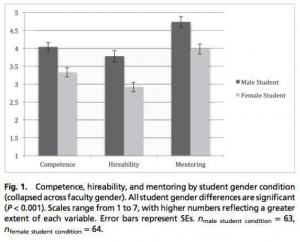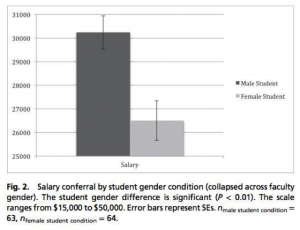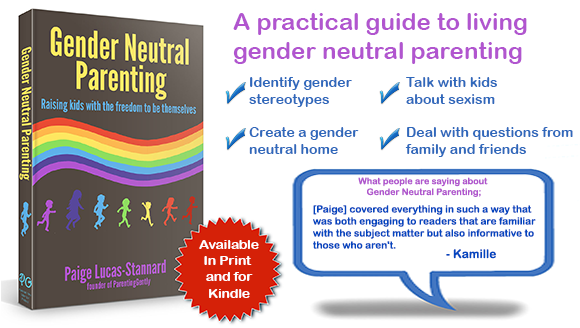
Source: Teach Media
Adapted from Gender Neutral Parenting: Raising Kids with the Freedom to Be Themselves.
When talking about Gender Neutral Parenting (GNP), a common misconception arises about bias.
That is that bias, in general, is a trait only exhibited by “bad” people. Racists, sexists, homophobes – “those” people are biased. Not us. We’re the good ones.
But what we need to understand is that we are all biased.
Bias and stereotyping is – quite literally – how the human brain works.
In order to store vast amount of information, the brain groups similar things together. Over time, some of this becomes completely subconscious so that even unknowingly, we do things in a biased manner.
Experimental psychologists have tested this theory extensively.
I had the good fortune to see Mahzarin Banaji speak on the subject. She is a researcher at Harvard that has spent her career studying how we don’t know our own minds. She describes her work thusly:
For example, if asked “How much do you smoke?” a smoker who smokes 4 packs a day may purposely report smoking only 2 packs a day because they are embarrassed to admit the correct number. Or, the smoker may simply not answer the question, regarding it as a private matter. (These are examples of being unwilling to report a known answer.) But it is also possible that a smoker who smokes 4 packs a day may report smoking only 2 packs because they honestly believe they only smoke about 2 packs a day. (Unknowingly giving an incorrect answer is sometimes called self-deception; this illustrates being unable to give the desired answer).
It’s called implicit association. At the website, you can even take online tests to determine some of your implicit biases around issues of race, gender, and sexuality.
What they have found, along with other researchers, is that social biases are universal.
For example, a study at Yale sent application materials from a student applying for a lab manager position to scientists. Half the scientists were given the application with a male name attached, and half were given the exact same application with a female name attached.
The results are astounding:
In this first graph, you can see how the scientists rated the applications on competence, hireability, and desire to serve as mentors. The application with the female name lagged behind the one with the male name.
This chart compares the salary they would offer to the applicant. You can see again the exact same application with a female name was good for $4,000 less in salary.
This isn’t news, right? This is good ol’ sexism.
The kicker is that there was no difference in how the applications were rated by male or female scientists. Yes, female scientists were just as likely to underrate the female application.
This is the heart of bias.
These women (and the men) were not overtly sexist in their reasoning. They didn’t say “because she’s a woman” or “because she’ll have kids and take off work.” These are people who, like you and me, would be appalled to find out they discriminated based on gender.
Bias is very often unconscious and eliminating bias is not really possible. Our goal, then, is to be aware of it so we can think twice and find other ways to equalize the bias.
In Lise Elliot’s book Pink Brain Blue Brain, she details the small differences that exist between boys and girls at birth.
For example, boys are about 4-5 ounces heavier and 1/2 inch longer at birth. Boys also have slightly larger heads and thus are slightly more difficult births.
The real issue isn’t how different boys and girls are, but how parents react to those small differences that turn them into the much larger differences society associates with boys and girls.
For example, “common wisdom” says that girls are more social and boys are more physical. Studies, however, don’t bear this out.
In one experiment, mothers were asked to guess the steepness of a carpeted slope that their 11-month olds would be able to crawl. Then the children actually crawled the slope, and the difference between actual and mother-predicted angles was noted.
The results showed that both boys and girls were able to crawl the same degree of incline. However, the predictions of the mothers were correct within one degree for the boys and underestimated their daughter’s ability by nine degrees.
What this shows is that the presumption that boys are more physical causes parents to encourage their boys more in physical activities while cautioning their girls. This further translates into providing more opportunities for boys to be physical and fewer for girls.
The result?
Boys actually do develop stronger physical skills than girls. But not because of anything innate or biological, but rather because of the gender roles that the parents subconsciously projected onto their babies.
When looking at how social babies are, studies have similarly found that there is no significant difference between newborns’ attention to human faces versus inanimate objects.
And yet, by 4-6 months, girls are much more likely to look at and respond to faces than boys. Why is that?
One measurable difference in boy and girl infants is fussiness.
Boys tend to cry more and for longer periods of time and take longer to develop a stable sleeping pattern. Researchers have noted that parents are more likely to “shush” or ignore their boys crying than girls.
As a result, they get less social interaction than girls who are generally calmer and “easier.” It becomes a self-fulfilling prophecy, then, that the boys are less social.
There is nothing specifically about maleness that causes boys to be more physical and less social, but societal interactions quickly make this true – prior to puberty, at least. After puberty, males tend to be larger and stronger, but in infancy and childhood, there is very little difference.
Another interesting study found that mothers tended to ignore boys’ facial expressions of pain perhaps subconsciously encouraging them to “be tough,” while mothers tended to ignore girls’ facial expressions of anger. This is probably something none of the mothers were consciously aware of.
This is why this is such an important goal of GNP.
If we can identify areas where we may have a bias, we can direct our awareness there to overcome it or compensate for it.
Let’s look at some ways to compensate for implicit bias in our parenting:
1. Pause before Telling Your Girls to ‘Be Careful’
I know the feeling of having your teeny baby climb the monkey bars, but you might be more scared simply because they’re girls.
Kids in general benefit from your confidence in them.
Make sure you are giving that confidence to your girls.
2. Engage Girls in Physical Activities
It doesn’t have to be sports (if, for example, you don’t like the competitiveness).
Think hop scotch, balance toys, yoga, and tumbling.
Our girls should have balls around (all kids should)!
The running and kicking and jumping that come from playing with a big beach ball are invaluable to developing physical confidence.
3. Pause before You Shrug off Your Boy’s Tears or Pain
Even if you don’t believe in “boys don’t cry,” you may implicitly give less comfort in an unconscious attempt to make them strong.
When they scrape their knee, don’t insist that “you’re okay.” Instead, empathize and say, “Ouch! Are you okay?”
4. Intentionally Spend 20 Minutes a Day in Positive Interaction with Boy Infants
Since boys can be fussier, we spend more time in negative interaction.
I don’t mean “negative” like yelling or being mean, but negative as in shushing, rocking, and other activities to get them to settle. As a result, we spend less time with eye-to-eye contact and cooing or babbling back and forth.
We do it instinctively with all babies, but be very intentional about doing so with your boys.
5. Allow Safe Expressions of Anger in Boys and Girls
We sometimes treat anger as the forbidden feeling. But with safe expression, anger is a crucial human emotion.
Validate the emotion (“You look very angry”) and give it a positive outlet while limiting inappropriate behavior (“We don’t hit when we’re angry, but maybe we can stomp on the floor?”).
Here’s the kicker: When it is your daughter as opposed to your son, you might be more likely not to allow a physical display of anger – squelching even stomping or hitting a pillow – because girls are “supposed” to be sweet and demure.
But all children need to learn healthy ways to deal with anger – your girls included.
***
For GNP to be successful, we need to remove overt sexism as well as implicit sexism. Recognizing our own bias, we can curtail the negative effects of implicit sexism and its effect our kids.
Do you catch your own implicit sexism sometimes? How do you overcome it?
For more information about raising kids with Gender Neutral Parenting, read Paige’s new book Gender Neutral Parenting: Raising Kids with the Freedom to Be Themselves.
[do_widget id=”text-101″]
Paige Lucas-Stannard is a parenting educator and writer and the founder of ParentingGently.com, which offers resources to help progressive parents find their authentic voices and implement respectful, values-based (and fun!) parenting in their homes including her new book, Gender Neutral Parenting: Raising kids with the freedom to be themselves. Follow her on Twitter @babydust, on Facebook, and on Pinterest. Read her articles here.
Search our 3000+ articles!
Read our articles about:
Our online racial justice training
Used by hundreds of universities, non-profits, and businesses.
Click to learn more























